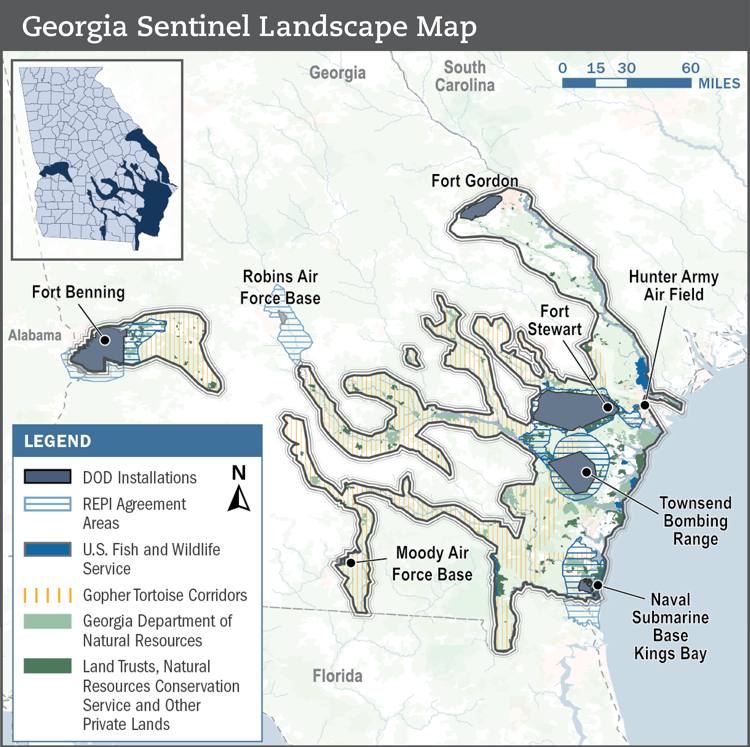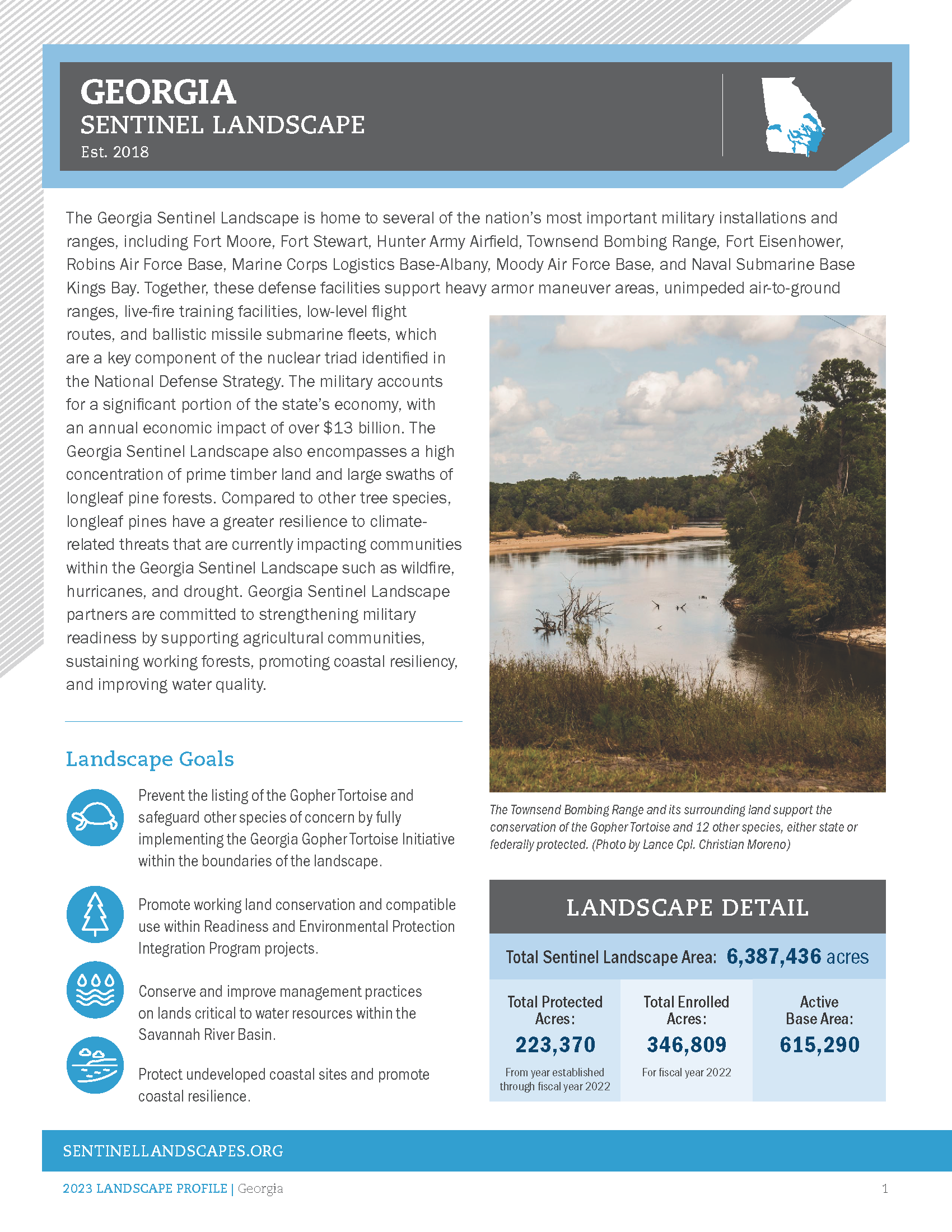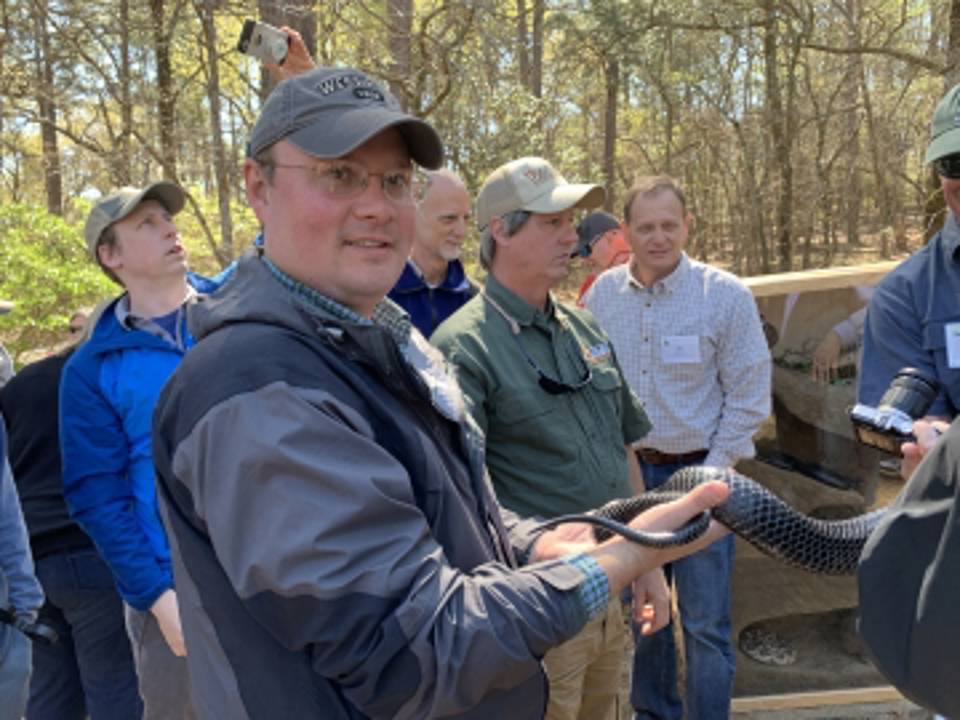Georgia Sentinel Landscape
-
Georgia
-
Established 2018
About
The Georgia Sentinel Landscape is home to several of the nation’s most important military installations and ranges, including Fort Benning, Fort Stewart, Hunter Army Airfield, Townsend Bombing Range, Fort Eisenhower, Robins Air Force Base, Marine Corps Logistics Base-Albany, Moody Air Force Base and Naval Submarine Base (NSB) Kings Bay. Together, these defense facilities support heavy armor maneuver areas, unimpeded air-to-ground ranges, live fire training facilities, low-level flight routes, and ballistic missile submarine fleets, which are a key component of the nuclear triad identified in the National Defense Strategy. The military accounts for a significant portion of the state’s economy, with an annual economic impact of over $13 billion[1]. The Georgia Sentinel Landscape also encompasses a high concentration of prime timber land and large swaths of longleaf pine forests. Georgia Sentinel Landscape partners are committed to strengthening military readiness by supporting agricultural communities, sustaining working forests, promoting coastal resiliency, and improving water quality.

Total Funding by Partner
| Partner | FY2017 | FY2018 | FY2019 | FY2020 | FY2021 | FY2022 | FY2023 |
|---|---|---|---|---|---|---|---|
| USDA | $10.42M | $12.82M | $12.36M | $13.20M | $32.82M | $7.48M | $5.64M |
| DOW | $0.00M | $0.00M | $0.00M | $0.00M | $0.00M | $0.00M | $0.00M |
| DOI | $0.00M | $0.09M | $0.04M | $7.90M | $5.00M | $2.71M | $0.09M |
| State | $15.84M | $3.40M | $1.52M | $37.56M | $31.18M | $3.50M | $1.16M |
| Local | $0.00M | $0.00M | $0.00M | $0.00M | $0.00M | $0.00M | $0.00M |
| Private | $7.53M | $23.63M | $8.52M | $11.98M | $22.22M | $0.17M | $2.38M |
| DoD | $3.51M | $10.08M | $11.18M | $19.27M | $1.97M | $9.09M | $7.06M |
Total Acres Protected and Enrolled
| Acres Protected (Since Designation) | 226272 |
|---|---|
| Acres Enrolled (During FY23) | 255013 |
Our Partners
Federal Partners
- National Parks Conservation Association
- U.S. Department of Agriculture, Farm Service Agency (FSA)
- U.S. Department of Agriculture, Forest Service (USFS)
- U.S. Department of Agriculture, Natural Resource Conservation Service (NRCS)
- U.S. Department of the Interior, Fish and Wildlife Service (USFWS)
- U.S. Department of the Interior, National Park Service (NPS)
- U.S. Department of War, Readiness and Environmental Protection Integration (REPI)
Resources
-

Georgia Profile
Meet the Coordinator

Ken Bradley
In May 2018, Ken retired as an Army Lieutenant Colonel with 24 years of active federal service. Ken is a 1998 graduate of the United States Military Academy at West Point and also earned a Master's in Civil Engineering from Missouri University of Science and Technology. He served as an engineer officer in the 3rd Infantry Division, 1st Cavalry Division and most recently the Mississippi Army National Guard as the Environmental Program Manager where he managed Camp Shelby's Army Compatible Use Buffer Program.